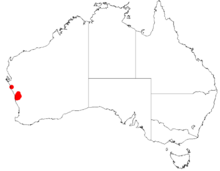| Pityrodia viscida | |
|---|---|
| Conservation status | |
 Priority Four — Rare Taxa (DEC) | |
| Scientific classification | |
| Kingdom: | Plantae |
| Clade: | Tracheophytes |
| Clade: | Angiosperms |
| Clade: | Eudicots |
| Clade: | Asterids |
| Order: | Lamiales |
| Family: | Lamiaceae |
| Genus: | Pityrodia |
| Species: | P. viscida |
| Binomial name | |
| Pityrodia viscida W.Fitzg. | |

| |
| Occurrence data from the ALA | |
Pityrodia viscida is a flowering plant in the mint family Lamiaceae and is endemic to the south-west of Western Australia. It is an erect shrub with sticky hairy stems, egg-shaped to narrowly elliptic leaves and white bell-like flowers.
Description
Pityrodia viscida is an erect shrub that typically grows to a height of 30–60 cm (12–24 in), its stems and branches covered with sticky hairs. The leaves are mostly arranged in opposite pairs, egg-shaped to narrowly ellipic, mostly 7–13 mm (0.28–0.51 in) long, 3–5 mm (0.12–0.20 in) wide and sessile. The upper surface of the leaves is glabrous and sticky, the lower surface covered with soft, yellowish-white hairs. The flowers are arranged singly in upper leaf axils, on a sticky, hairy pedicel 1–2 mm (0.039–0.079 in) long. The five sepals are 7–9 mm (0.28–0.35 in) long and joined for about half their length, with lance-shaped lobes 4–6 mm (0.16–0.24 in) long. The petals are white, 9–12 mm (0.35–0.47 in) long and joined at the base to form a gradually spreading upwards, with two "lips" with wavy or toothed edges. The lower lip has three lobes, the middle lobe broadly elliptic to more or less round, 5–6 mm (0.20–0.24 in) long and 4–5 mm (0.16–0.20 in) wide, the side lobes 3–5 mm (0.12–0.20 in) long. The two upper lobes are oblong and 4–6 mm (0.16–0.24 in) long. The four stamens extend beyond the end of the tube, the lower pair longer than the upper two. Flowering occurs from September to December or in January and February, and is followed by an oval, softly hairy fruit 3.5–5.0 mm (0.14–0.20 in) long.
Taxonomy and naming
Pityrodia viscida was first formally described in 1918 by William Vincent Fitzgerald and the description was published in the Journal of the West Australian Natural History Society. The specific epithet (viscida) means "sticky", referring to the leaves and sepals.
Distribution
This pityrodia grows in sandy laterite, mainly between Mingenew and Three Springs in the Avon Wheatbelt and Geraldton Sandplains bioregions of south-western Western Australia.
Conservation
Pityrodia viscida is listed as "Priority Four" by the Government of Western Australia Department of Biodiversity, Conservation and Attractions, meaning that it is rare or near threatened.
References
- "Pityrodia viscida". Australian Plant Census. Retrieved 27 February 2023.
- ^ Munir, Ahmad A. (1979). "A taxonomic revision of the genus Pityrodia (Chloanthaceae)". Journal of the Adelaide Botanic Gardens. 2 (1): 87–89. Retrieved 27 February 2023.
- ^ Fitzgerald, William V. (1904). "Additions to the West Australian Flora". Journal of the West Australian Natural History Society. 2 (1): 30. Retrieved 27 February 2023.
- ^ "Pityrodia viscida". FloraBase. Western Australian Government Department of Biodiversity, Conservation and Attractions.
- "Pityrodia viscida". APNI. Retrieved 27 February 2023.
- Sharr, Francis Aubi; George, Alex (2019). Western Australian Plant Names and Their Meanings (3rd ed.). Kardinya, WA: Four Gables Press. p. 337. ISBN 9780958034180.
- "Conservation codes for Western Australian Flora and Fauna" (PDF). Government of Western Australia Department of Parks and Wildlife. Retrieved 27 February 2023.
| Taxon identifiers | |
|---|---|
| Pityrodia viscida | |